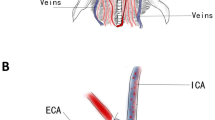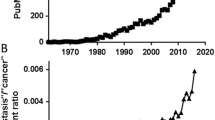Abstract
Triple negative breast cancer (TNBC), when associated with poor outcome, is aggressive in nature with a high incidence of brain metastasis and the shortest median overall patient survival after brain metastasis development compared to all other breast cancer subtypes. As therapies that control primary cancer and extracranial metastatic sites improve, the incidence of brain metastases is increasing and the management of patients with breast cancer brain metastases continues to be a significant clinical challenge. Mouse models have been developed to permit in depth evaluation of breast cancer metastasis to the brain. In this study, we compare the efficiency and metastatic potential of two experimental mouse models of TNBC. Longitudinal MRI analysis and end point histology were used to quantify initial cell arrest as well as the number and volume of metastases that developed in mouse brain over time. We showed significant differences in MRI appearance, tumor progression and model efficiency between the syngeneic 4T1-BR5 model and the xenogeneic 231-BR model. Since TNBC does not respond to many standard breast cancer treatments and TNBC brain metastases lack effective targeted therapies, these preclinical TNBC models represent invaluable tools for the assessment of novel systemic therapeutic approaches. Further pursuits of therapeutics designed to bypass the blood tumor barrier and permit access to the brain parenchyma and metastatic cells within the brain will be paramount in the fight to control and treat lethal metastatic cancer.






Similar content being viewed by others
References
Palma G, Frasci G, Chirico A, Esposito E, Siani C, Saturnino C, Arra C, Ciliberto G, Giordano A, D’Aiuto M (2015) Triple negative breast cancer: looking for the missing link between biology and treatments. Oncotarget 6(29):26560–26574
Niikura N, Saji S, Tokuda Y, Iwata H (2014) Brain metastases in breast cancer. Jpn J Clin Oncol 44(12):1133–1140
Arvold ND, Oh KS, Niemierko A, Taghian AG, Lin NU, Abi-Raad RF, Sreedhara M, Harris JR, Alexander BM (2012) Brain metastases after breast-conserving therapy and systemic therapy: incidence and characteristics by biologic subtype. Breast Cancer Res Treat 136(1):153–160
Lin NU, Amiri-Kordestani L, Palmieri D, Liewehr DJ, Steeg PS (2013) CNS metastases in breast cancer: old challenge, new frontiers. Clin Cancer Res 19(23):6404–6418
Yoneda T, Williams PJ, Hiraga T, Niewolna M, Nishimura R (2001) A bone-seeking clone exhibits different biological properties from the MDA-MB-231 parental human breast cancer cells and a brain-seeking clone in vivo and in vitro. J Bone Miner Res 16(8):1486–1495
Daphu I, Sundstrom T, Horn S, Huszthy PC, Niclou SP, Sakariassen PO, Immervoll H, Miletic H, Bjerkvig R, Thorsen F (2013) In vivo animal models for studying brain metastasis: value and limitations. Clin Exp Metastasis 30(5):695–710
Chen EI, Hewel J, Krueger JS, Tiraby C, Weber MR, Kralli A, Becker K, Yates JR 3rd, Felding-Habermann B (2007) Adaptation of energy metabolism in breast cancer brain metastases. Cancer Res 67(4):1472–1486
Kim LS, Huang S, Lu W, Lev DC, Price JE (2004) Vascular endothelial growth factor expression promotes the growth of breast cancer brain metastases in nude mice. Clin Exp Metastasis 21(2):107–118
Palmieri D, Fitzgerald D, Shreeve SM, Hua E, Bronder JL, Weil RJ, Davis S, Stark AM, Merino MJ, Kurek R et al (2009) Analyses of resected human brain metastases of breast cancer reveal the association between up-regulation of hexokinase 2 and poor prognosis. Mol Cancer Res 7(9):1438–1445
Tsai MS, Shamon-Taylor LA, Mehmi I, Tang CK, Lupu R (2003) Blockage of heregulin expression inhibits tumorigenicity and metastasis of breast cancer. Oncogene 22(5):761–768
Adkins CE, Nounou MI, Mittapalli RK, Terrell-Hall TB, Mohammad AS, Jagannathan R, Lockman PR (2015) A novel preclinical method to quantitatively evaluate early-stage metastatic events at the murine blood-brain barrier. Cancer Prev Res (Phila) 8(1):68–76
Adkins CE, Mohammad AS, Terrell-Hall TB, Dolan EL, Shah N, Sechrest E, Griffith J, Lockman PR (2016) Characterization of passive permeability at the blood-tumor barrier in five preclinical models of brain metastases of breast cancer. Clin Exp Metastasis 33(4):373–383
Heyn C, Ronald JA, Ramadan SS, Snir JA, Barry AM, MacKenzie LT, Mikulis DJ, Palmieri D, Bronder JL, Steeg PS et al (2006) In vivo MRI of cancer cell fate at the single-cell level in a mouse model of breast cancer metastasis to the brain. Magn Reson Med 56(5):1001–1010
Heyn C, Ronald JA, Mackenzie LT, MacDonald IC, Chambers AF, Rutt BK, Foster PJ (2006) In vivo magnetic resonance imaging of single cells in mouse brain with optical validation. Magn Reson Med 55(1):23–29
McFadden C, Mallett CL, Foster PJ (2011) Labeling of multiple cell lines using a new iron oxide agent for cell tracking by MRI. Contrast Media Mol Imaging 6(6):514–522
Percy DB, Ribot EJ, Chen Y, McFadden C, Simedrea C, Steeg PS, Chambers AF, Foster PJ (2011) In vivo characterization of changing blood-tumor barrier permeability in a mouse model of breast cancer metastasis: a complementary magnetic resonance imaging approach. Invest Radiol 46(11):718–725
Tao K, Fang M, Alroy J, Sahagian GG (2008) Imagable 4T1 model for the study of late stage breast cancer. BMC Cancer 8:228
Cailleau R, Young R, Olive M, Reeves WJ Jr (1974) Breast tumor cell lines from pleural effusions. J Natl Cancer Inst 53(3):661–674
Hamilton AM, Aidoudi-Ahmed S, Sharma S, Kotamraju VR, Foster PJ, Sugahara KN, Ruoslahti E, Rutt BK (2015) Nanoparticles coated with the tumor-penetrating peptide iRGD reduce experimental breast cancer metastasis in the brain. J Mol Med (Berl) 93(9):991–1001
Perera M, Ribot EJ, Percy DB, McFadden C, Simedrea C, Palmieri D, Chambers AF, Foster PJ (2012) In Vivo Magnetic Resonance Imaging for Investigating the Development and Distribution of Experimental Brain Metastases due to Breast Cancer. Transl. Oncol 5(3):217–225
Ribot EJ, Martinez-Santiesteban FM, Simedrea C, Steeg PS, Chambers AF, Rutt BK, Foster PJ (2011) In vivo single scan detection of both iron-labeled cells and breast cancer metastases in the mouse brain using balanced steady-state free precession imaging at 1.5 T. J Magn Reson Imaging 34(1):231–238
Fitzgerald DP, Emerson DL, Qian Y, Anwar T, Liewehr DJ, Steinberg SM, Silberman S, Palmieri D, Steeg PS (2012) TPI-287, a new taxane family member, reduces the brain metastatic colonization of breast cancer cells. Mol Cancer Ther 11(9):1959–1967
Lyle LT, Lockman PR, Adkins CE, Mohammad AS, Sechrest E, Hua E, Palmieri D, Liewehr DJ, Steinberg SM, Kloc W et al. (2016) Alterations in Pericyte Subpopulations are Associated with Elevated Blood-Tumor Barrier Permeability in Experimental Brain Metastasis of Breast Cancer. Clin Cancer Res [Epub ahead of print]
Palmieri D, Lockman PR, Thomas FC, Hua E, Herring J, Hargrave E, Johnson M, Flores N, Qian Y, Vega-Valle E et al (2009) Vorinostat inhibits brain metastatic colonization in a model of triple-negative breast cancer and induces DNA double-strand breaks. Clin Cancer Res 15(19):6148–6157
Palmieri D, Duchnowska R, Woditschka S, Hua E, Qian Y, Biernat W, Sosinska-Mielcarek K, Gril B, Stark AM, Hewitt SM et al (2014) Profound prevention of experimental brain metastases of breast cancer by temozolomide in an MGMT-dependent manner. Clin Cancer Res 20(10):2727–2739
Sartorius CA, Hanna CT, Gril B, Cruz H, Serkova NJ, Huber KM, Kabos P, Schedin TB, Borges VF, Steeg PS et al (2016) Estrogen promotes the brain metastatic colonization of triple negative breast cancer cells via an astrocyte-mediated paracrine mechanism. Oncogene 35(22):2881–2892
Stuart-Harris R, Caldas C, Pinder SE, Pharoah P (2008) Proliferation markers and survival in early breast cancer: a systematic review and meta-analysis of 85 studies in 32,825 patients. Breast 17(4):323–334
Leone JP, Leone BA (2015) Breast cancer brain metastases: the last frontier. Exp. Hematol Oncol 4:33
Deeken JF, Loscher W (2007) The blood-brain barrier and cancer: transporters, treatment, and Trojan horses. Clin Cancer Res 13(6):1663–1674
Acknowledgements
PJF received funding for this research from the Canadian Institutes of Health Research. Operating grant number # MOP 130447. We thank Dr. Patricia Steeg, Deputy Chief, Women’s Malignancies Branch, Center for Cancer Research at the National Cancer Institute, Bethesda, Maryland for providing the 231-BR and 4T1-BR5 cell lines.
Funding
PJF received funding for this research from the Canadian Health Institute of Research. Operating grant number # MOP 130447.
Author information
Authors and Affiliations
Corresponding author
Ethics declarations
Conflicts of interest
AMH declares no conflict of interest.
Research Involving Human Participants and/or Animals
All applicable international, national and institutional guidelines for the care and use of animals were followed. All procedures performed in studies involving animals were in accordance with the ethical standards of the institution at which the studies were conducted. This article does not contain any studies with human participants performed by any of the authors.
Rights and permissions
About this article
Cite this article
Hamilton, A.M., Foster, P.J. In vivo magnetic resonance imaging investigating the development of experimental brain metastases due to triple negative breast cancer. Clin Exp Metastasis 34, 133–140 (2017). https://doi.org/10.1007/s10585-016-9835-5
Received:
Accepted:
Published:
Issue Date:
DOI: https://doi.org/10.1007/s10585-016-9835-5




